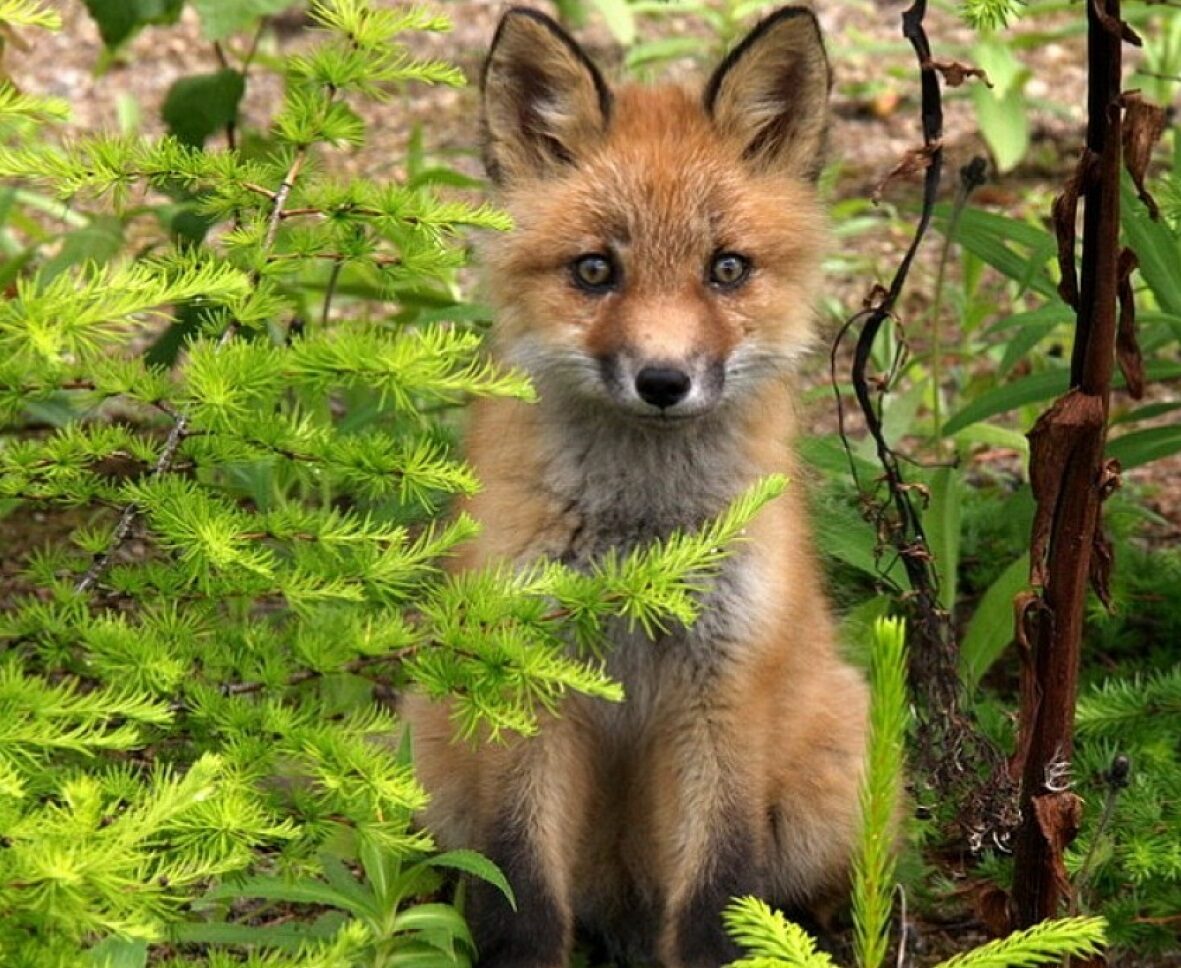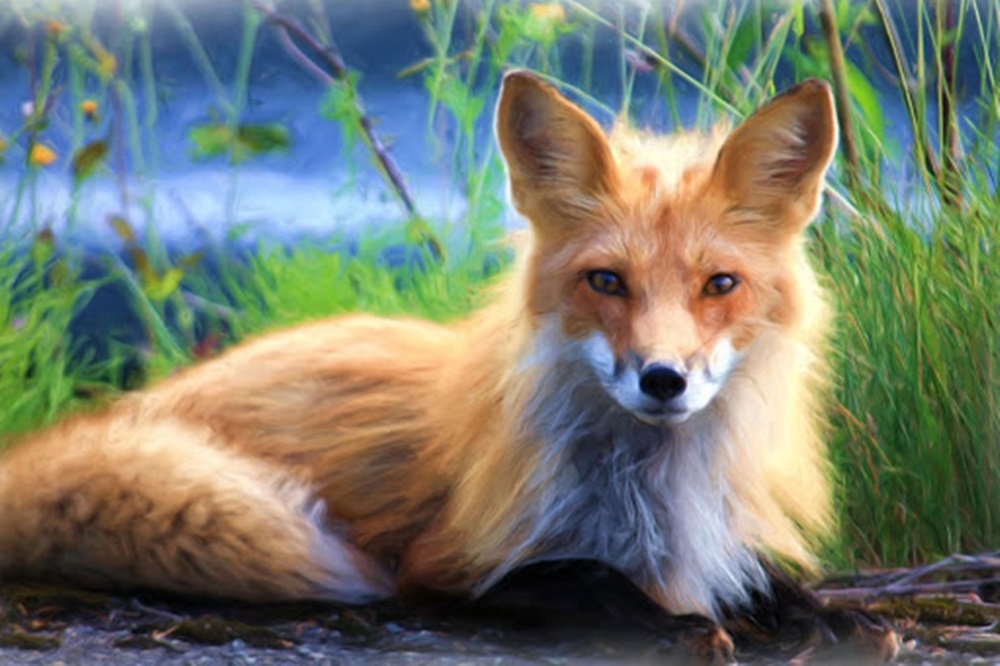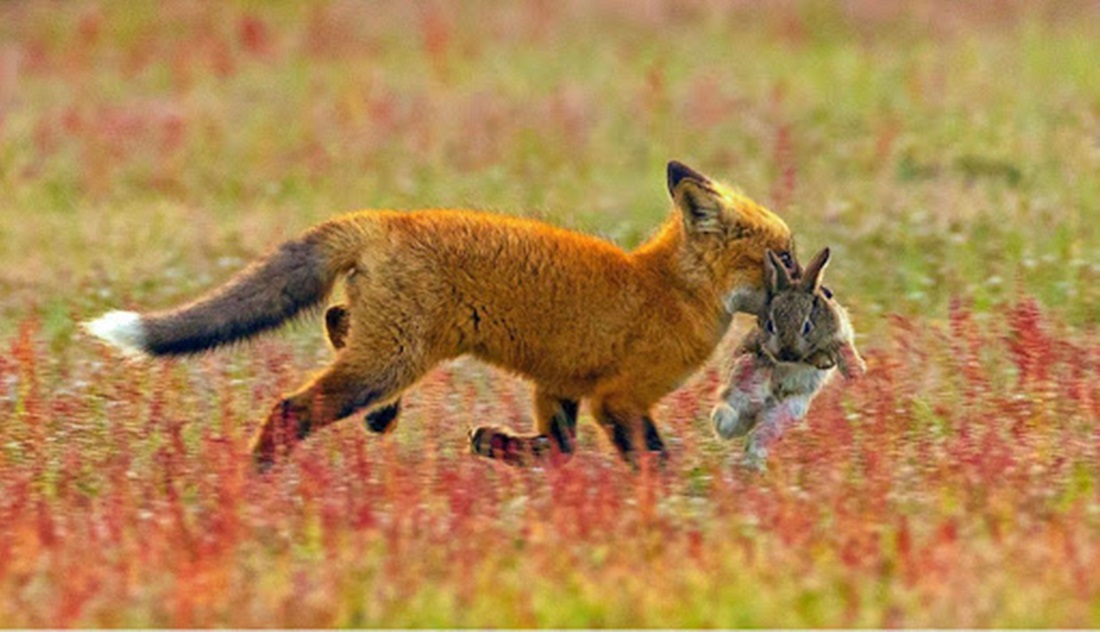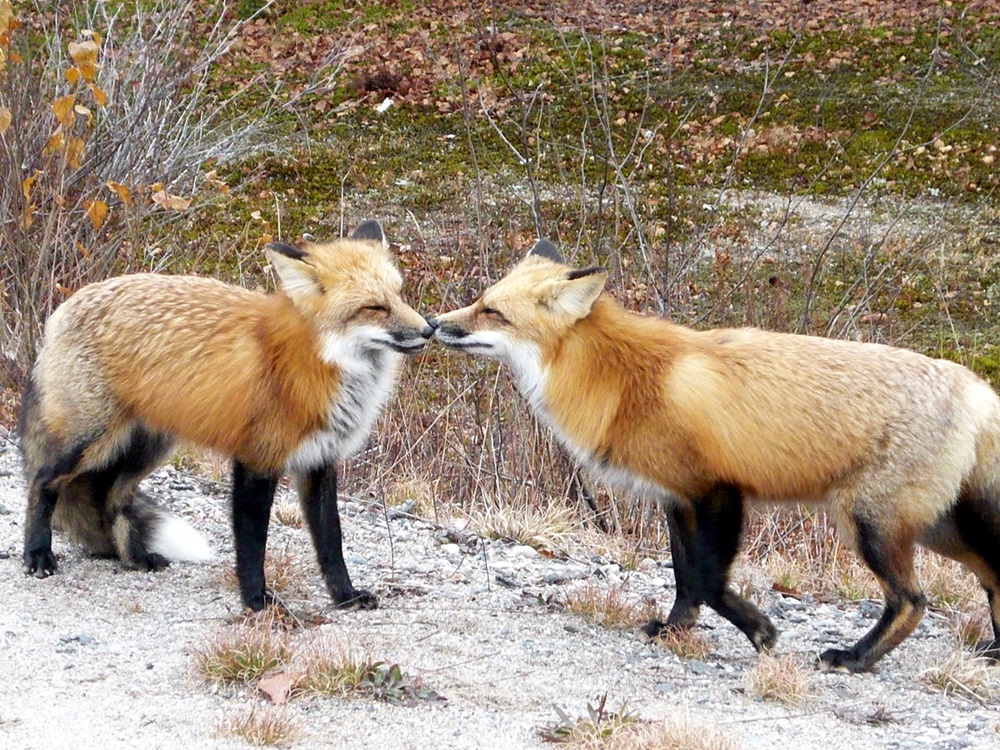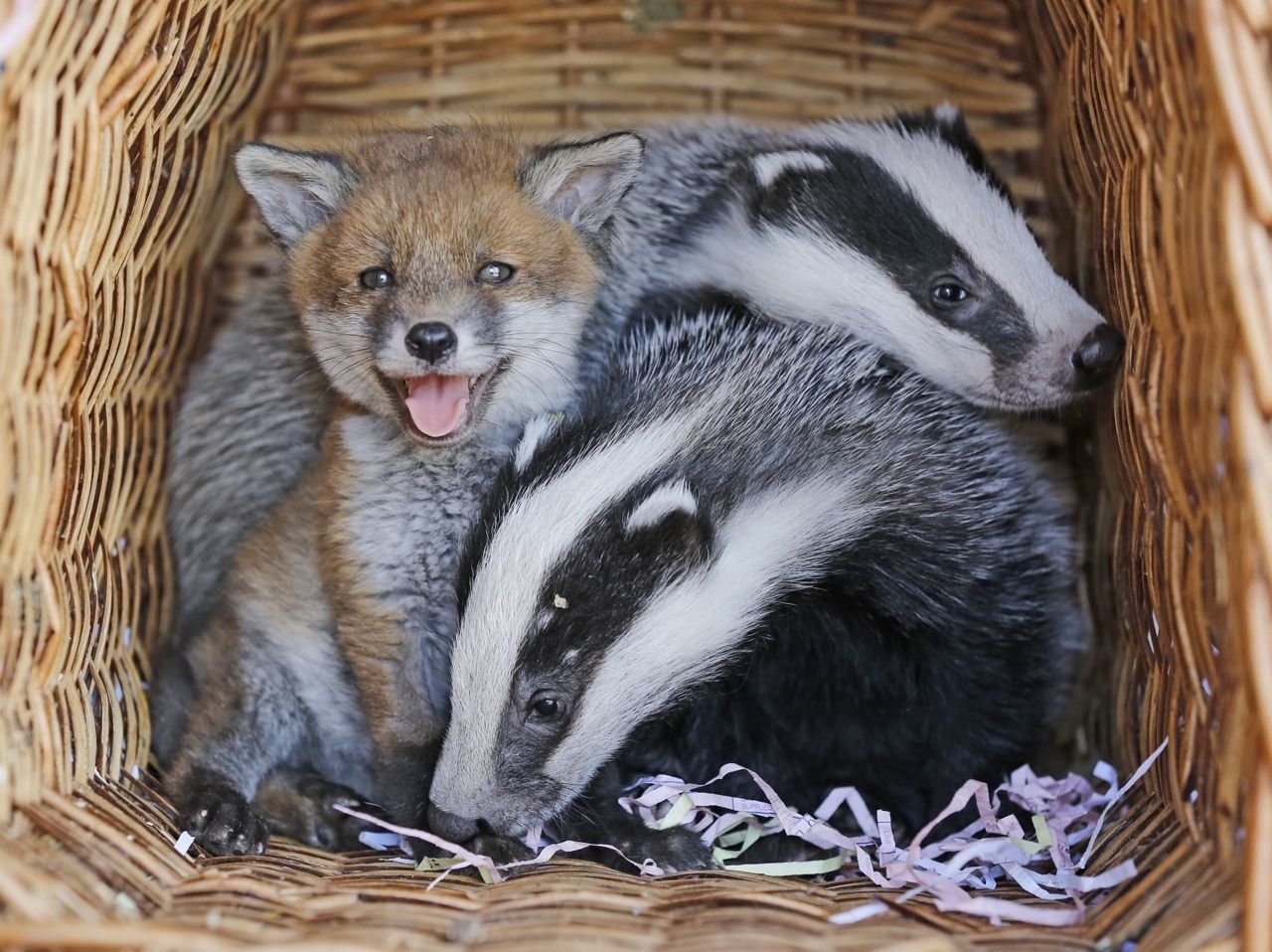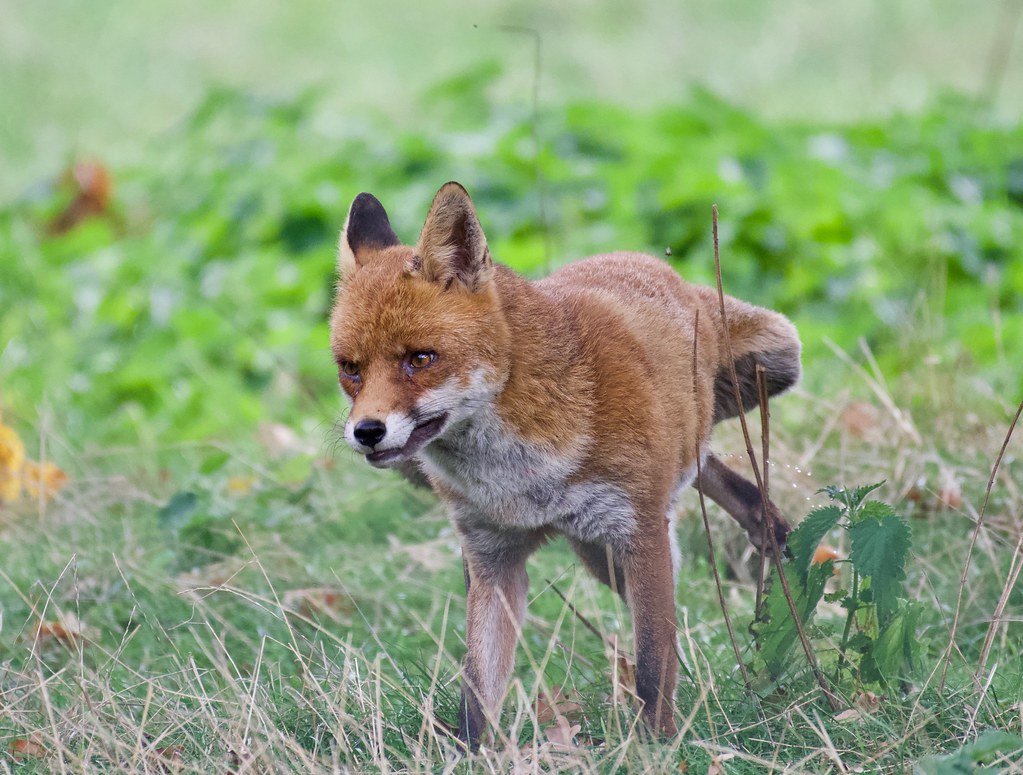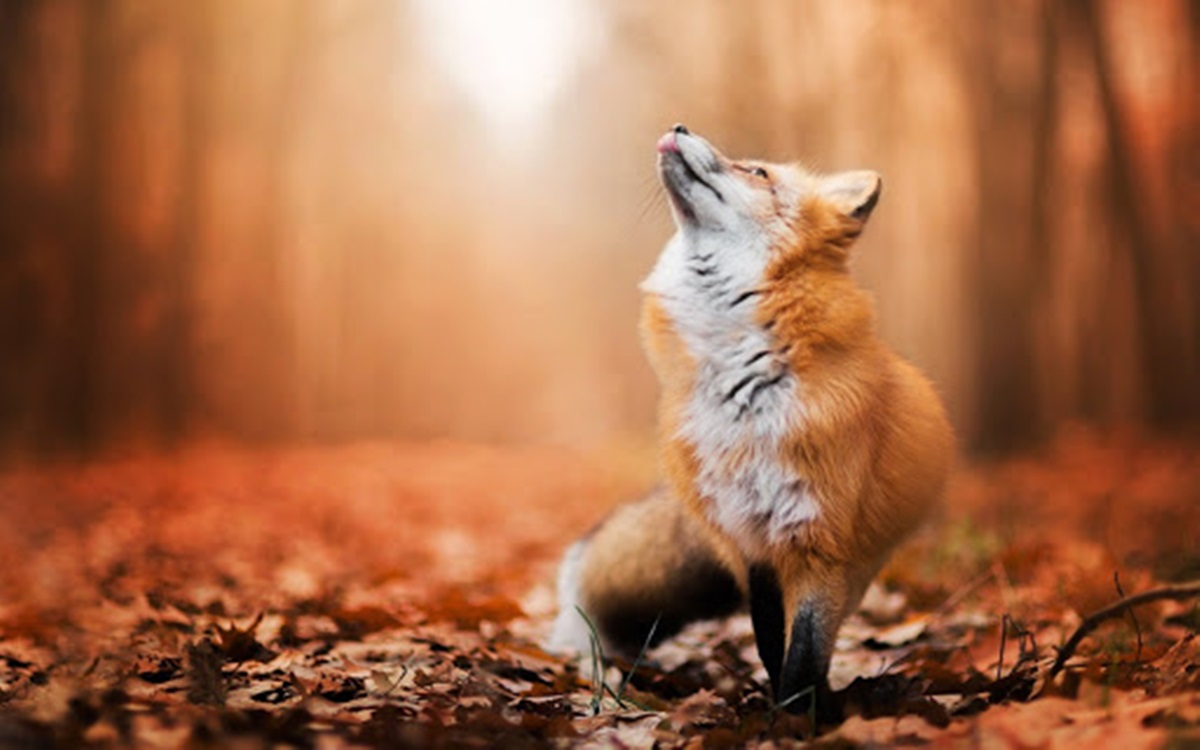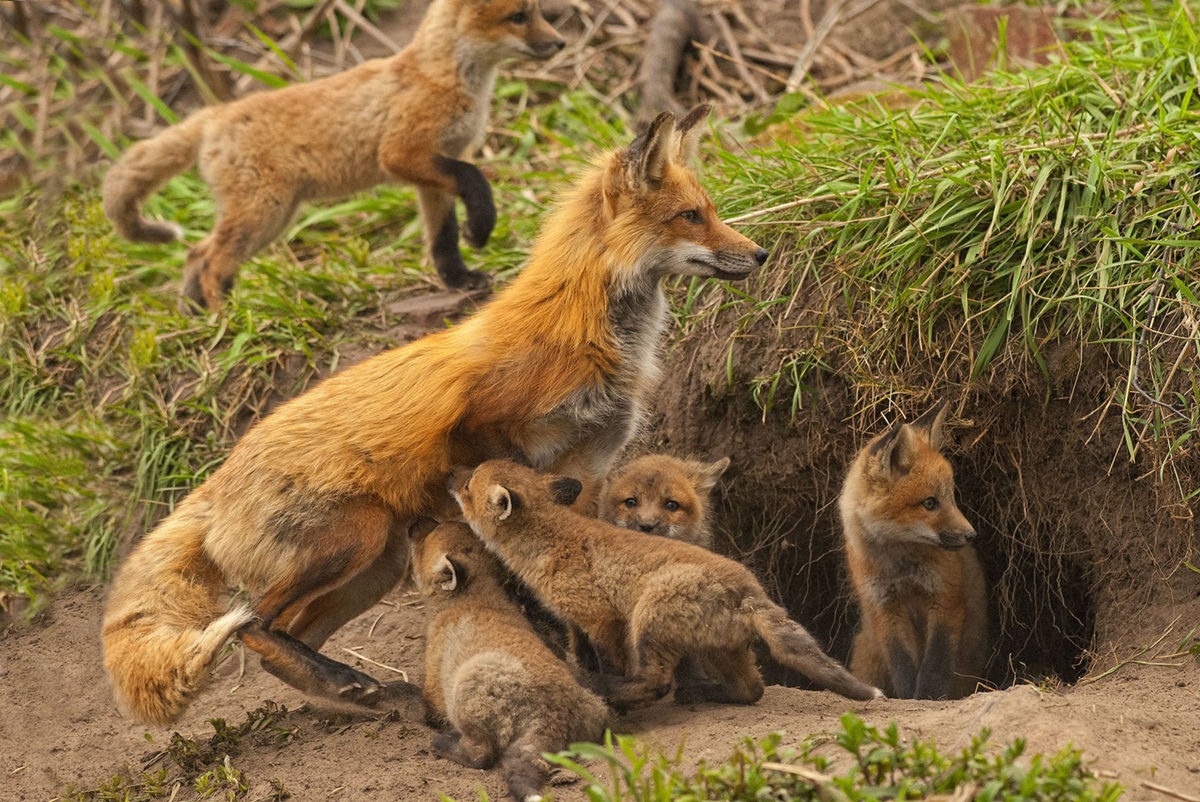The red fox is a mammal that belongs to the canidae family. It is also known as the common fox and its scientific name is "Vulpes vulpes" which comes from the Latin word vulpes which literally means "fox". The habitat of this beautiful animal is very varied, as they are adaptable to almost any environment, in addition to being a legend in many countries.
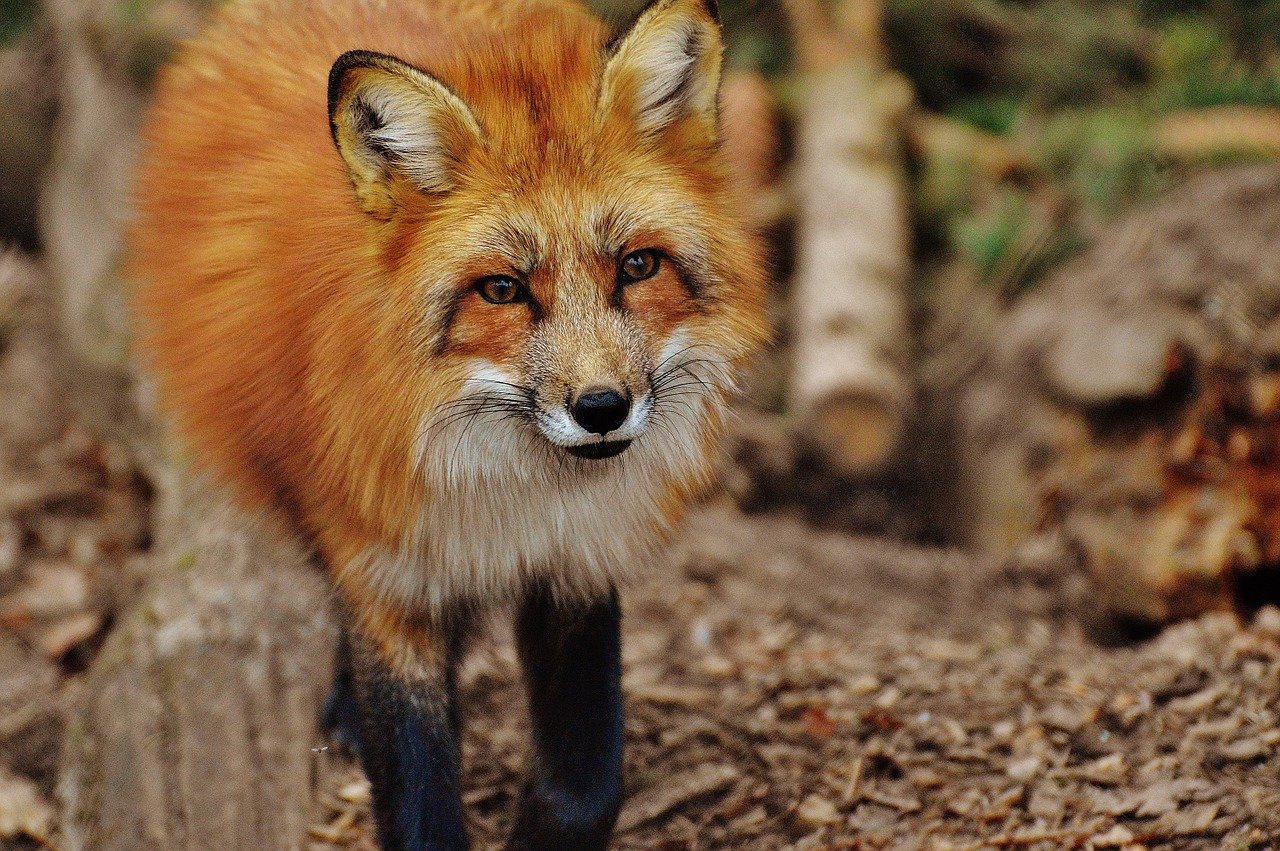
Origin of the red fox
The red fox or common fox is one of the carnivorous mammals that is distributed almost everywhere in the world. Its habitat is found throughout the Holarctic zone (boreal continents of the world) which are Europe, Asia, North Africa, North America and Oceania. Although in the year 1868 they were introduced by man in Australia.
They are mostly nocturnal, because being so silent and stealthy, their best hunting time is at night and in the middle of the dark. During the day they can almost always be seen hidden in bushes resting or hiding from the sun or predators, they can also be hidden inside their burrows which are hidden between rocks, ravines or in areas of abundant grass.
Red foxes are capable of living in almost any ecosystem, they can be in forests that lose all their leaves in winter, in meadows, in areas where vegetation is low, tall trees do not grow (alpine tundra), boreal forests and steppes. They also have the peculiarity of being able to adapt and live well in urbanized and populated areas with large numbers of humans.
The appearance of the red fox in Australia has had great consequences for the species that are indigenous to the country.
These North American mammals are from the boreal areas of the region, but were brought to the temperate regions which were from the common foxes of Europe and were brought to the US between the years 1650-1750. Fossils of red foxes exist today from the time of North America.
These beautiful animals come from the Palearctic region, which is located in the northern part of the entire European continent and extends from the Iberian Peninsula to Japan. On the African continent it is found in the Mediterranean area and in the Nile River. There are three subspecies of this mammal on the Indian continent, the Tibetan fox, the Kashmiri fox and the desert fox.
Characteristics of the red fox
With an approximate weight between 3 and 14 kilos, the red fox is considered a small animal, however it is positioned as the largest among all the subspecies of the vulpes. Their weight will depend on the fox habitat. They have a head between 46 and 90 cm and a tail that can reach 55 centimeters in length.
The red fox is characterized by sexual dimorphism, this means that the male is usually larger than the female by 15%. One of the most common ways to tell the size of a fox without measuring it directly is by the size of its tracks, which average 4.4 centimeters wide and 5.7 centimeters long.
It has an elongated snout, large and pointed ears, which help them to have a very good hearing, a long tail that can be almost as long as its own body, long and slender legs which make them fast when it comes to running and good jumpers.
As their name says, in these foxes the reddish color of their fur generally predominates, the tips of their ears as well as the ends, their legs have black hair, their long tail has a tuft of white hair at its tip. we can also see in his belly, cheeks, chin and throat.
The red color of these dogs can vary from reddish brown to orange red or copper, however, their range of colors can vary on some occasions, having ocher, gray, black and white as a palette. The most common is that the upper part is uniform, however, some specimens have been seen that have small spots or stripes that make them very distinctive.
The foxes that have gray and black as dominant colors are known as silver foxes, there are not many existing ones, just an approximate 10% of the population of foxes, however, this is the most common variety found among foxes captive bred.
Those that have other types of dark patterns such as spots on the face or body or two stripes; one that covers both shoulders and another that runs through the entire column, they only represent 30% of the population and are called cross foxes.
In the North American region, foxes have beautiful long, fluffy and soft fur, unlike those from Europe that have long and not so fluffy fur. Red foxes, like the others, are covered by a layer of thicker and longer hair when they approach the autumn and winter seasons and which protects them from the winter cold, it falls off when spring arrives, leaving it alone. covered by a slightly shorter and less dense coat.
The eyes of red foxes do not have a common pupil, it is rather elliptical and is positioned vertically. These are nocturnal animals, as they mostly hunt and move at night, however, their vision during these dark hours is poor, they see better during the day than at night, so they are always guided essentially by their sense of smell and hearing, which are very good. .
Thanks to their long and strong legs, red foxes can reach a speed of up to 72 km, which helps them to be able to capture prey that are fast and also to be able to flee from their predators, in addition to them they can make great jumps.
Its long and fluffy tail is part of its charming and iconic image and is used for various functions, it can be used as a pillow when the fox is sleeping, it is also used to protect itself from the sun, with it it can even communicate with its own species and to drive away insects that land near or on your body. In addition to the aforementioned, their tail also helps them maintain their balance when they jump or when they run after their prey or to escape.
The white tip of its tail has the sole purpose of being an identifier that helps humans distinguish it from other existing canids. Unlike other canine species, foxes in general do not have facial muscles that help them show their teeth the way dogs do when they growl or feel threatened.
ecology or habitat
If we talk about adaptability, the common fox is an expert on this subject, it is capable of adapting to the environment without problems. For this reason, they can be found in forests, mountains, plains, beaches, deserts, tundra and even in areas populated by humans (urban or suburban) although they are not residents of the latter, however, they could be seen loitering occasionally over there.
Their habitat depends a lot on the amount of prey they can find, in areas where they are more abundant is where we can find a greater number of red foxes.
Food
Although red foxes are known as Carnivorous animals, the natural thing about this animal is that it is an omnivore and an opportunist by nature. Their prey can vary in size, ranging from the smallest, half-centimeter insects, to meter-and-a-half birds.
Foxes do not have a specific preference regarding what their food refers to, they can eat insects of any variety and even crabs, in addition to this they can also hunt small animals, among them are the Chipmunk, mice, toads, fish, among others. Red foxes also choose to feed on fruit, especially berries.
It has been known that the red fox can even hunt baby deer. For this reason in Scandinavia one of the main reasons for the mortality of fawns is due to red foxes and their hunting.
If the situation calls for it, the fox can eat carrion. If you are in the adjoining areas of urbanity, the foxes can enter the dumps and take food from them, they eat everything that can be edible and can even steal or take the food that was hunted by another animal. In some cases they have been seen stealing food from pets. The closer you are to the human population, the less you need to hunt as you will find food much easier.
Red foxes are usually solitary hunters unlike other mammals. To locate their prey they use their highly developed sense of hearing, when they locate the prey either in the bushes, in their burrow or hidden, they jump on them using the surprise factor. In addition to this, it can also stalk its prey by hiding until it gets close enough to them and thus capture them either immediately or after a short chase.
The reason why they go hunting alone is because they are very jealous of their food and do not like to share it, the only way this rule can be broken naturally is when a female fox has cubs or in the hunting season. courtship, there they can be seen sharing, the regular thing is that the male is the one who gets the food and shares it with his courted female.
The fox's stomach is small, for this reason they do not usually eat too much during the day, they only eat half a kilo or a kilo of food per day. Unlike wolves and dogs that normally eat in proportion to their body size, the red fox can only eat half of that, so their size is not proportional to the amount of food they eat in a day.
These mammals can store food that will be used in the future, especially at times when food is less abundant. For this they bury their food at an approximate depth between 5 and 10 centimeters deep. These food caches are not usually large, on the contrary, they prefer to make several of them throughout their territory, this prevents the entire supply from being stolen if another animal finds one of their holes.
Reproduction
When red foxes enter their mating season, they look for a partner with whom they spend the entire reproductive cycle, that is, they become monogamous during that reproductive season. However, there have been records where a fox has been seen to have more than one partner during the reproductive season, even a pair of males has been observed cooperating with each other to mate with the other's partner.
In temperate climate zones, the reproductive season is between December and April, however, it can be seen that it is between January and February that they are seen performing their act of mating or copulation.
Females have a single heat that lasts between 1 and 6 days. The act of mating or copulation can last approximately up to 26 minutes, while the gestation cycle lasts 52 days. The number of offspring will vary depending on the health of the mother, a healthy female has more chances of having more offspring, this is also influenced by the amount of food she can find, her sexual maturity and the amount of fox population in the herd. place.
When a pair of foxes has young in winter, both cooperate with each other to raise them together, the litters are usually composed of between 4 and 6 skunks. The largest litter recorded in history was 13 puppies.
The young are born covered in flock (baby fur), take between 8 and 14 days to open their eyes and about a month to leave the den for the first time. After 8 weeks of visa his fur becomes a cream color and his weight can reach a kilogram.
Puppies are weaned at 9 weeks of age. Between 7 or 10 weeks they are already able to finally leave their dens permanently and their sexual maturity arrives when they are between 9 or 10 months old, this means that they will be able to start reproducing in the following mating season after having born.
Wild foxes tend not to exceed 3 years of life, due to all that they have to overcome to survive and overcome the various climates and seasons. Instead, in captivity, they can live for approximately 12 years. It is estimated that their time and quality of life in captivity is similar to that of dogs and wolves that share this condition.
Relationships of red foxes with other species
Despite their agility and stealth, red foxes have natural predators, including wolves, golden eagles, cougars, and bears. Other of its predators are the boreal lynxes, studies have shown that when both species share the same habitat the population of foxes tends to decrease, although it is not very common, this almost always happens in winter, because the scarcity of food warrants it and in spring, this is the season where the foxes usually do explorations for territories and they are exposed.
In North America, the red fox shares its abundance of species with the gray foxes, although both species are far apart in terms of their habitat tastes, since they are opposites. Common foxes prefer to live in open areas, wooded hills, riverbanks. They can be found in swamps, mountains and areas where bushes are abundant, as this way you can use it more to your advantage when making your surprise attacks. The gray fox, for its part, despite being smaller than the red fox, is considered a more aggressive and dominant predator.
Although the gray fox is dominant over the red fox, the latter is above the hierarchy of arctic foxes as they are much smaller and calmer. Another species of fox that competes against the red fox but is at a disadvantage is the kid fox, because as its name says, it is small and, in addition, it is in danger of extinction, so its population is scarce.
It has been found that in those territories where red foxes and coyotes cohabit, the foxes tend to stay out of the coyote's territory as they seem to prefer to avoid them and not risk having to fight them. On the occasions that they have been observed interacting with each other in the wild, they can be seen being hostile to each other or simply ignoring each other's presence.
Normally coyotes are the most aggressive between both species, so it is assumed that these are the ones that mostly start the disputes, because until now there have been no records where we can see that a red fox is the one that starts the fight between these two species. unless their pups are near them, there if you can see that the hostility begins from the fox, because they protect their pups. To the surprise of many, both species have been seen eating together, it is not very common, but it has happened on occasions
Common foxes share a diet with golden jackals, these two mammals coexist and share territory in Israel. Red foxes continually ignore the marks left by jackals in their territories, however preferring to avoid face-to-face encounters with jackals.
However, it has been shown that when there are a large number of jackals in a territory, the foxes decrease considerably, it is assumed that this is due to the constant confrontations for food and that the red fox has a disadvantage against the golden jackals.
In some areas of Europe, European badgers have been seen killing red fox pups. These two compete for smaller meals: fries, rodents, eggs, invertebrates. However, these two species have rarely been seen being violent between them, rather in the encounters between them that have been observed, they prefer to go the path of mutual indifference. There are even records where foxes are seen sharing their burrows with European badgers. So it can be said that despite everything there is a coexistence between them.
Red Fox Behavior
Due to the adaptability that red foxes have and the different habitats in which they live, they can have very different behaviors from each other, being the case that you can even see some that, despite obviously being of the same species, act so differently. They appear to be a different species of animal.
In places where foxes have to coexist with humans, it can be noticed that they tend to come out and be more active during twilight or at night because it is safer for them. They are generally animals that hunt alone, only during the courtship season they can be seen eating or hunting together, and those females that have young. When the food they get is more than they can eat for the day, they bury it and store it so they can eat it later.
Vulpes are territorial animals, they constantly defend their territories. In winter they can be seen patrolling in pairs, since that is usually the mating season, while in summer they can be seen guarding their territory alone. The breadth of its territory varies depending on the amount of food that area has, if the land has an abundant amount of food, its territory will approach 12 square kilometers. On the contrary, if it has little feed variability, it can be extended to a capacity of up to 50 km2.
The way a fox marks its territory is by rubbing a gland next to its tail in specific places. This gland secretes a substance with a strong odor that is composed of thiols (substance similar to sulfur) and thioacetates. These natural chemical compounds are similar to those found in skunks, although the one found in foxes is smaller in quantity.
The strong scent that they project when marking territory can be detected by humans who are within a radius of approximately 2 or 3 meters. However, unlike skunks, foxes do not use this stench as a method of defense against other animals or living beings, they only use it to delimit their territory.
The foxes within their territory have a large number of dens that are scattered throughout the area, these may have been made by the fox itself or it may have stolen them from other animals that also take refuge in dens. Red foxes have one main den, this tends to be the largest and it is there that they spend the winter and where the females have their young and they spend their first weeks of life. Smaller dens are primarily used for food storage or emergency shelters, especially when territory is being patrolled and something makes them want to take cover.
The way red foxes communicate with each other is through sounds or body language. Mostly, members of the same family tend to communicate more. Foxes have different sounds that they use to communicate, to warn of danger or to call each other. Another way of communicating is by smell, this is the reason why they mark their food, dens and territory with urine, feces or with the substance secreted by their scent gland.
Can the red fox be a pet?
It is increasingly common to see videos on social networks where red foxes are shown living among humans and being trained as if they were pets, for this reason many people begin to wonder if these mammals can be pets, just as they are. Dogs and cats. However, we must always keep in mind that red foxes and all their subspecies are Wild animals they have instincts and can become dangerous. That is why it is not recommended to keep them as pets.
We must always keep in mind that wild animals belong to nature and should remain there, this will help the different species to survive and reduce mistreatment towards them.
The red foxes and the human
Humans have always had two opinions about foxes, one of them is completely disliked, they consider the animal a vermin because they hunted their chickens or other small animals, other humans admire and love foxes since they are beautiful specimens, smart and bold. On the other hand, the fur of this species has been highly coveted for many years, not only that of the red fox but also the different families of this species.
Today many accuse red foxes of carrying rabies, and for this reason they are frowned upon and there are even those who decide to hurt them and even kill them. On the other hand, many documentaries have pointed to them as direct benefactors of agriculture since they can reduce rodents and vermin considerably, causing fewer crops to be damaged.
Although the only place in the world where the red fox is considered a protected species is Hong Kong, there are many countries that have banned fox hunting, including: the United Kingdom, Scotland, England and Wales. These hunting ban reforms have greatly helped the species to be conserved. It is expected that in the coming years more countries will join this cause and ban this cruel tradition that kills not only red foxes, but also many species of animals.
red foxes in culture
Foxes have been part of many of the cultures of various countries for hundreds of years, they are part of the mythology and folklore of different nations. In North America, Asia and Europe they can be seen appearing even in television programs and movies as mystical beings with a strong personality. They are considered as animals with unmatched cunning that tend to deceive their victims, but they are also admired by those who know their intelligence and dynamism.
Since ancient times, the European fable has included the participation of foxes, especially in the fables of Aesop, La Fontaine and Samaniego. In these stories the fox is known to be very intelligent and cunning beings, so their roles can be villain, trickster, swindler, intelligent, wise and observant. Their qualities are many, so they can play any role in history without losing the essence of what is believed to be the fox's personality.
Many historians affirm that from the Middle Ages to the French Revolution it was the fox who was taken in stories as the representation of the peasants, since they admired the mammal for being cunning beings who changed the facts so that they always benefited, as well that they compared that and assumed it was the perfect strategy to use to be able to overcome the state, the church and the aristocracy.
In Japan, mythology also makes use of the fox as part of its history. In the country of the Rising Sun, the fox is known as Kitsune (狐 [きつね]) which literally means "fox", which are spirits of the forest that are responsible for protecting the forest and the villagers who live in the vicinity of the forest. forest they protect.
In Japanese culture they are also known as highly intelligent beings who have magical powers that they use to protect, this power increases as the fox increases in age and knowledge. According to Japanese folklore and mythology, the easiest way to know the age and power of a fox is by its tail, the more years, power and knowledge it has, the greater the number of tails it has. The most powerful fox will have at most nine tails and is known in Japanese as the kyuubi no kitsune which means "literally nine-tailed fox" (九尾の狐 [きゅうびのきつね]).
The kitsune is known to have direct contact with the Shinto god, Inari. According to Japanese mythology, the kitsunes are the messengers that unite humans with the god, in addition, they are considered the relatives of Inari, a relative has the same role as a server, their job is to assist their master and protect him.
Kitsunes can go from having an animal appearance to acquiring the appearance of a human (mostly female), in many stories it has been known that while they adopt their "humanoid" identity they can fulfill the role that a lady normally fulfills, she can be part of a family or a lover. Other stories say that they take advantage of their "humanity" to get closer to the man so they can play tricks on him. They are always jovial and with an overflowing energy, that is why they are always active.
Offerings are usually presented to these mythological beings as if they were deities, there are even forests where you can find small temples that are dedicated solely to the kitsune. The Japanese kitsune shares a certain similarity with the foxes of neighboring cultures such as the Korean where they are known as "Kumiho" and in the Chinese they are called "Huli Jing".
Trading their skins
Fox fur has been desired and appreciated since ancient times due to its softness and color palette. It is said that in New England, the natives considered a single silver fox pelt to be equal in monetary cost to 40 beaver pelts. That is why when a tribal chief agreed to take a silver fox fur as a gift, this was taken as an implicit message that an offer of peace between one or more tribes had been agreed upon.
Among the color palettes that common foxes have, the most sought after and desired is that of silver foxes, since this color is not common, it is mostly obtained by breeding foxes in captivity. Many people have long dedicated themselves to breeding these foxes in order to later market their skins. This started in Canada in 1878.
Fox fur is used to create different garments, from scarves to coats. Currently there are many groups of people who are against this, most of them are people who are in favor of animal protection and who fight to ban the sale of these skins, because they do not believe it is fair that for nesting sacrifice the life of an animal that has the same right to live as a human being.
Is the red fox a domestic predator?
Many farmers have a strong dislike for red foxes as they are one of the main predators of Domestic animals, among them are rabbits, cats, dogs, chickens or other farmyard animals. In order to avoid this type of attack, most farm keepers or breeders choose to lock their animals in cages, this serves to separate them from the foxes and thus prevent them from being attacked.
If the farmer chooses to use fences to separate his animals from the fox, they must have an altitude that exceeds two meters, in addition, he must ensure that there are no objects or places that can be used or climbed near it and that makes it easier for the fox to enter the pen from the top. However, none of this is 100% certain, as there are some records where foxes are observed climbing over the metal fence and entering to hunt their prey.
Apart from the height, the fence or cage should have or be on a hard surface that does not allow the fox to dig and can enter after digging a trench. If a fox enters some of these structures, it will be extremely easy for it to obtain its prey because the space will be reduced and it will have nowhere to escape. The fox may even kill not just one but several prey.
The most common prey of the red fox on a farm is poultry, however, it can sometimes dare to hunt some young, whether they are cattle, lambs, goats, sheep or other small animals that are easy to kill. It will only attack one of these prey as adults on occasions when food is very scarce or when it has not eaten for a long time.
A Mayan fox mostly catches its prey when it is lying down, this can be known because the bite attacks are usually on the neck or back. The attack of a red fox on barnyard animals is easily differentiated from that of wolves because foxes do not usually cause fractures in their prey when eating them, unlike wolves that break bones with their teeth while eating. they feed.
It is very common for hunted prey to disappear from the place where the attack occurred, as foxes normally take the entire body of the animal to their den, because there it will store what is left over or share its food with its cubs. Although in their first stage of life the pups feed on their mother's breast milk, they later begin to eat the food that their mother brings to the den.
